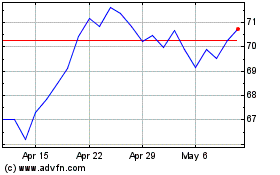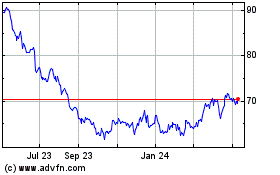Regulators Tweak Food-Stamp Rules for Grocers
December 09 2016 - 12:20PM
Dow Jones News
In a rare tuneup to the $74 billion food-stamp program, U.S.
regulators deemed potato chips and ice cream too unhealthy to count
as staple foods.
The U.S. Department of Agriculture made other changes to the
Supplemental Nutrition Assistance Program this week that fell short
of recommendations from many public-health advocates.
The new rules bar stores from accepting food stamps if they draw
more than half their sales from prepared meals or foods that are
heated up on the spot, such as microwavable pizzas. Draft proposals
earlier this year had called for a much lower threshold, 15% of
food sales from such items.
The new rules released on Thursday removed additional fatty and
sugary items like potato chips and ice cream from a list of foods
that were previously considered staples because their main
ingredients are potatoes and milk, respectively. But that fell
short of some health advocates' expectations. Grape juice and
canned mushroom soup could still count toward the minimum staples
stores must stock to accept food stamps, for instance, because of
the fruit and vegetables they contain.
"I'm disappointed that the rules don't go as far as what was
proposed early this year," said Danielle Nierenberg, president of
Food Tank, a nutrition advocacy group. "USDA has missed an
opportunity to increase the availability of and access to healthier
foods for low-income Americans."
The earlier proposals also recommended leaving food with
multiple ingredients like frozen pizza or canned soup off the
staple list. The outcome is a win for the makers of such products,
like General Mills Inc. and Campbell Soup Co., which feared they
would lose shelf space as retailers added new items to meet the
requirements.
But retailers still criticized the new guidelines as too
restrictive. Stores must now stock seven varieties of staples in
each food category: meat, bread, dairy, and fruits and vegetables.
Three of the items must be perishable. The USDA suggested smaller
stores add products like chilled shrimp, chicken nuggets or canned
salmon to offerings like beef jerky and canned tuna.
Doug Beech, director of government relations for Casey's General
Stores Inc., said seven varieties of meat is asking too much.
Bacon, deli ham and hot dogs sold at Casey's 1,941 small grocery
stores in the Midwest, he pointed out, will all count just as
pork.
"Our customers aren't familiar with, and can't afford, duck and
lamb," he said. "This will force stores to re-do our inventory and
replace foods that sell with ones that might not.
More than 45 million people received funds from the program last
year, at an average of $126.83 a month, up from three million
people in 1969 receiving $42.82, when adjusted for inflation. From
2010 to 2015, the percentage redeemed at convenience stores, liquor
stores, dollar stores, pharmacies and gas stations nearly doubled
to 11.6%, or $8 billion, USDA says.
The USDA moved ice cream, cakes and more into a category of
nonnutritious foods that can't be counted toward the staples stores
must stock to accept food stamps. For instance, Twinkies can no
longer be considered bread, and pork rinds aren't considered a
staple meat.
"These foods are typically deficient in important nutrients,"
the USDA said.
The American Cancer Society applauded that change, but called
for increased nutrition education and new efforts to help
low-income consumers afford healthier foods.
More changes to the food-stamp program may lie ahead. The new
rules were published a day after the House Committee on Agriculture
released a report calling for major changes to the program, which
Republicans on the committee say discourages recipients from
finding better-paid work.
Write to Annie Gasparro at annie.gasparro@wsj.com
(END) Dow Jones Newswires
December 09, 2016 12:05 ET (17:05 GMT)
Copyright (c) 2016 Dow Jones & Company, Inc.
General Mills (NYSE:GIS)
Historical Stock Chart
From Mar 2024 to Apr 2024

General Mills (NYSE:GIS)
Historical Stock Chart
From Apr 2023 to Apr 2024
